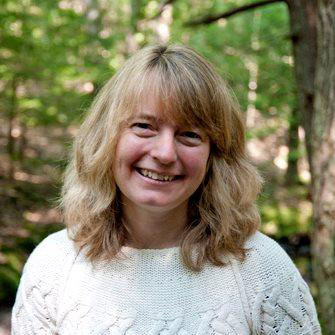Kristen Lindquist: Happy Birthday, Gray Seals!
On these bitterly cold days of the new year, as harbors grow a skin of ice and frosty sea smoke clouds the horizon, it's hard to imagine that on an exposed island out in the frigid bay, gray seals are giving birth.
In fact, this time of year the gray seal rookery on Penobscot Bay's Seal Island is hopping with activity. Hundreds of female seals haul out on the windswept rocky island to bear their pups and hang out for a few weeks. Mature bull seals follow them ashore to take advantage of the opportunity to mate with as many as are willing while they're all in one place. And so the cycle of life continues.
Until recent years, however, this perpetuation of life wasn't something to be taken for granted. Throughout the 1900s, the gray seal was hunted to the point of real scarcity, with just a few thousand left in New England. Massachusetts offered a bounty of $5 per seal nose until the early 1960s. And fisherman continued to hunt them even after the bounty was rescinded, believing the seals were eating too many cod.
It wasn't until passage of the Marine Mammal Protection Act in 1972 that numbers of both seal species that breed in Maine—gray and harbor—began to rebound. The recovery of seal populations in New England is a true conservation success story. Scientists aided by new survey technology (namely, Google Earth) estimated that Cape Cod and surrounding islands hosted as many as 50,000 gray seals in 2016.
The rookery on aptly named Seal Island, part of the Maine Coastal Islands National Wildlife Refuge, is the gray seal's primary breeding site in Maine. According to National Audubon, Seal Island has become the second largest pupping colony of the four in North America, with around 500 pups born there each winter. Audubon's Project Puffin and explore.org have even teamed up to offer a live "seal pupping cam" so you can spy on the baby seals during their first weeks. (In the summer, this becomes a "puffin cam" for the protected seabird nesting island.)
Here on the Maine coast we typically see the more common harbor seal close to shore. Rockport Harbor's Andre, of book and movie fame, was a harbor seal (despite being played by a sea lion in the movie!) Offshore your chances for seeing either species improve.
Size is one way to tell them apart. The gray seal grows much larger than a harbor seal—a full-grown bull can weigh over 800 pounds, twice the size of a harbor seal. But even if you only see the seal's head poking up out of the water, you can usually recognize which one it is: one look at the gray seal's distinctive, long schnoz makes it obvious why it's often called the horsehead seal. In fact, the gray seal's unflattering scientific name, Halichoerus grypus, means "hook-nosed sea pig." The harbor seal's puppy-cute face, on the other hand, has in part led to its nickname of "sea dog."
Nose aside, as with most baby animals, the gray seal pup is adorable. For the first few weeks of its life, it sports thick, woolly, white fur and dark, appealing eyes. Weighing 24 to 44 pounds at birth, the pup grows several pounds a day while guzzling its mother's fat-rich milk. An only child, it hogs all her milk and attention during the first few weeks of its life. Devoting herself to the demanding pup, the mother seal doesn't even eat during the time she's lactating. Instead, she stays by her pup's side, shielding it from the surge of freezing waves, being crushed to death by other seals in rookery, or being cannibalized by a bull seal. (On Seal Island, too, there's always the risk of rolling over unexploded ordnance from the decades when the island was used by the military for target practice.)
Imagine a seal rookery in winter: brutally cold, chilled by wind and snow, constantly battered by icy waves, crowded with the large bodies of noisy, smelly animals. For a seal pup, however, this is Eden. Life quickly grows tougher for the fat and fuzzy youngster. After several weeks its mother suddenly closes the milk bar, mates, and heads back out to sea to finally catch a meal. The weanling is essentially abandoned. Until it can swim for its supper, the pup lives off the fat stores built up during those weeks of sucking down fatty milk. It grows up fast, molting into a shorter, more water-friendly gray coat so that it too can hit the waves for food. If it doesn't learn to feed itself soon, it may starve.
The ocean offers a wide range of options for the young seal once it starts swimming and hunting for itself, including fish, lobster, octopus, sand eel, squid, even seabirds and the occasional harbor porpoise. The gray seal can dive deep and stay underwater for up to fifteen minutes at a time. Awkward-looking and ungainly on land, the seal is in its element in the sea: a graceful, powerful swimmer and efficient predator.
As with many marine mammals, the young seal runs a gamut of hazards as it struggles to survive after those first few idyllic weeks by mom's side, with a mortality rate of up to 50 percent in its first year. Natural predators include sharks and orcas. Human-created risks include entanglement with fishing nets, illegal shooting, and oil spills and other water pollution. But a strong, healthy gray seal can live well into its thirties—allowing many years of mid-winter returns to the joys of the rookery, to play its part in keeping the seal population growing.
 Kristen Lindquist is an amateur naturalist and published poet who lives in her hometown of Camden.
Kristen Lindquist is an amateur naturalist and published poet who lives in her hometown of Camden.
Winter life inside a beaver lodge
Migrating flickers and falcons
Orchids —They're not just in the tropics
• Meditations on an unlikely harbinger of spring
• Meditations on the Snow Goose
• Sky-watching during the holiday season
• Understanding the Aurora Borealis
• Get to know the constellation Gemini
• Celebrate September’s full moon
• Northern Sky basics with the Big Dipper
• Early Christmas morning: Look up! A full moon, and Orion bright in the sky
Event Date
Address
ME
United States






















